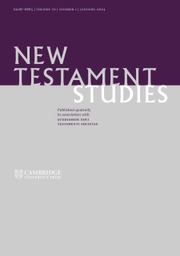Earlier today, Peter Montoro alerted me to a new cache of manuscripts just published by the Library of Congress. Since Peter is more familiar with the contents than me, I asked if he would introduce them for us.
 In 1949–1950, Kenneth Clark led an expedition to Mt. Sinai and Jerusalem that microfilmed over 2500 manuscripts on behalf of the American Foundation for the Study of Man, the Library of Congress, and the American Schools of Oriental Research. A full account of the expedition can be found here.
In 1949–1950, Kenneth Clark led an expedition to Mt. Sinai and Jerusalem that microfilmed over 2500 manuscripts on behalf of the American Foundation for the Study of Man, the Library of Congress, and the American Schools of Oriental Research. A full account of the expedition can be found here.
Earlier this year, Peter Head alerted us to the fact that the Library of Congress had made the entirety of its Sinai Microfilm collection freely available online. A descriptive checklist for this collection is available here, and the full collection can be accessed here.
The Jerusalem collection of the same expedition, containing slightly over 1000 additional manuscripts, has now also been made available and can be accessed here. This collection contains manuscripts in Greek (669), Georgian (125), Arabic (96), Armenian (32), and Syriac (27), as well as smaller numbers in other languages. The checklist for this collection can be accessed here. The numbers in the checklist appear to be drawn from the earlier and quite thorough catalogue by Athanasios Papadopulos-Kerameus (in Greek). In 1949–1950, Kenneth Clark led an expedition to Mt. Sinai and Jerusalem that microfilmed over 2500 manuscripts on behalf of the American Foundation for the Study of Man, the Library of Congress, and the American Schools of Oriental Research. A full account of the expedition can be found here.
In 1949–1950, Kenneth Clark led an expedition to Mt. Sinai and Jerusalem that microfilmed over 2500 manuscripts on behalf of the American Foundation for the Study of Man, the Library of Congress, and the American Schools of Oriental Research. A full account of the expedition can be found here.Earlier this year, Peter Head alerted us to the fact that the Library of Congress had made the entirety of its Sinai Microfilm collection freely available online. A descriptive checklist for this collection is available here, and the full collection can be accessed here.
I’ve added links to the volumes I’ve been able to locate at the bottom of the post. This catalogue can be quite useful as the descriptions in the checklist are brief to the point of cryptic and, in at least one case, simply incorrect. (E.g. Hagios Sabas 20 contains Chrysostom’s Homilies on Romans, not Matthew—I’ve been in contact with the LOC and this should be corrected soon in the online description.)
 |
| Interesting drawings in Panagios Taphos 87 |
I’ve also been informed that the 1952–53 expedition to Athos, containing over 200 additional manuscripts is scheduled to be made available sometime this fall. As a sneak preview, the checklist for this collection is available here.
Together these three collections form an enormous body of freely available manuscripts and should prove very useful to many lines of research.
Note on Downloading Manuscript Images
The LOC interface allows you to freely download these images at full resolution in either the JPEG2000(Jp2) or Tiff formats. While it is possible to click from image to image, downloading each one, I’ve found that it saves considerable loading time to get the link to one of the Jp2 files and simply change the numbers in the browser bar to get the needed folios.Links to the ΙΕΡΟΣΟΛΥΜΙΤΚΙ ΒΙΒΛΙΟΘΗΚΗ, by Athanasios Papadopulos-Kerameus
I have not yet been able to locate a PDF of the fifth and final volume of this series.
















